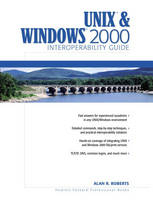
UNIX and Windows 2000 Interoperability Guide
Prentice Hall (Verlag)
978-0-13-026332-2 (ISBN)
- Titel ist leider vergriffen;
keine Neuauflage - Artikel merken
Nowadays, most organizations have deployed mixed-platform environments that leverage the best of both Windows 2000/NT and multiple Unix/Linux operating systems. Managing these environments requires fast access to information that's normally scattered across multiple books: step-by-step techniques for performing key tasks on each platform, as well as practical solutions for integrating them. Unix and Windows 2000 Interoperability Guide delivers all this, in a proven quick-reference format that saves time, effort, and money. Unlike competitive guides, Unix and Windows 2000 Interoperability Guide offers quick-reference coverage for all four leading versions of Unix: HP-UX, Linux, Solaris, and AIX. Alan Roberts focuses each chapter on a single key system administration task, explaining how each version of Unix handles the task, presenting precise "how-to" instructions, and offering practical interoperability tips. The book concludes with a detailed section on UNIX and Windows 2000 interoperability, focusing on the issue UNIX shops care about most: effective file and print sharing.
ALAN R. ROBERTS is a long-time UNIX system administrator who also holds an MCSE Certification. He has 13 years of system administration and research experience, first at the Boeing Company and later as a Solutions Specialist for Hewlett-Packard's Americas Technical Computing Advanced Technology Center (ATC). He currently works at EMC Corporation, specializing in network attached storage.
(NOTE: Each chapter concludes with a Conclusion and References.)
Preface.
Acknowledgments.
1. What Is UNIX?
In the Beginning. The New Face of UNIX. UNIX and Open Source Software. The Elements of UNIX. Is There More?
2. What Is Windows 2000?
A New Operating System. Windows 2000 Architecture. Elements of Windows 2000.
3. The Network Interface Layer.
Network Interface Cards and Drivers.
4. The Internet Layer.
ARP. IP.
5. The Transport Layer.
TCP. UDP. Network Application Interfaces.
6. Name Resolution.
Windows 2000. HP-UX. Nslookup Differences. Name Resolution Issues in a Mixed Environment.
7. DHCP and DNS.
DHCP Clients. Windows 2000 DHCP Server.
8. User Authentication.
Windows 2000. HP-UX. PAM Kerberos.
9. Basic TCP/IP Utilities.
General Observations. Finger. FTP. Tftp. Rsh and Rcp. Rexec. Telnet. Authentication Issues.
10. Windows Services for UNIX.
Telnet Client. Telnet Server. Server For NIS.
11. NFS File Sharing.
Basic Concepts. NFS and Windows 2000 Issues. Windows 2000 NFS Client/HP-UX NFS Server. Windows 2000 NFS Server/HP-UX NFS Client.
12. CIFS File Sharing.
CIFS Versus NFS. The Case for CIFS. CIFS Implementations. CIFS/9000 Server in a Windows 2000 Domain. CIFS/9000 Client in a Windows 2000 Domain.
13. Miscellaneous Interoperability Topics.
Network-Attached Storage. The X Window System. Printing.
Index.
| Verlagsort | Upper Saddle River |
|---|---|
| Sprache | englisch |
| Maße | 177 x 235 mm |
| Gewicht | 493 g |
| Themenwelt | Informatik ► Betriebssysteme / Server ► Unix / Linux |
| Informatik ► Betriebssysteme / Server ► Windows | |
| Informatik ► Betriebssysteme / Server ► Windows Server | |
| ISBN-10 | 0-13-026332-X / 013026332X |
| ISBN-13 | 978-0-13-026332-2 / 9780130263322 |
| Zustand | Neuware |
| Haben Sie eine Frage zum Produkt? |
aus dem Bereich


